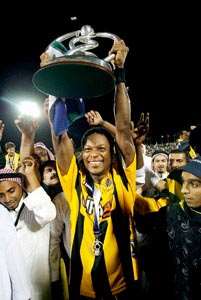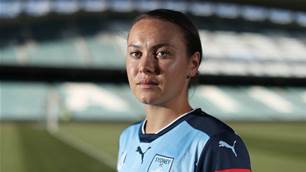An off-season oddity or the final frontier for Australian clubs? The true nature of the Asian Champions League will soon be revealed, as Sydney FC and Adelaide United embark on their own excellent adventure.
Page 1 of 3 | Single page
Football Federation Australia has been selling the benefits of Australia’s entry to the Asian Football Confederation (AFC) for more than a year now.
Aside from international football, the big benefit for the A-League’s clubs and supporters, it said, was going to be entry into the Asian Champions League (ACL) and the fame and fortune it would bring.
Yet even now, as we salute the pioneering Sydney FC and Adelaide United on their departure for this brave new world for Australian football, doubts remain over exactly how they’ll perform and whether the potential benefits are sufficient to warrant the clubs’ involvement. But then again, for most football fans getting the pronunciation of Seongnam Ilwha Chunma correct is going to be challenging enough.
So for those who don’t know a Red Diamond from a Shenhua or Kim Do-heon from Li Weifeng, here’s our look at the 2007 AFC Champions League.
The ACL proper was launched in August 2002, and has thus provided just four winners in its history. All but last year’s have hailed from the Middle Eastern countries of West Asia.
However, the competition has roots dating back to 1967, when Asian club competition properly began. In 2002, the Asian Champions Cup and the Asian Cup Winners Cup were merged into the new Champions League in similar reforms to those UEFA have undertaken in Europe over the past decade to create their own Champions League.
Jeonbuk Hyundai Motors of South Korea (Newcastle Jet Milton Rodriguez’s former team) were named 2006 ACL Champions following their victory over Al Karama of Syria at the beginning of November. The two-legged home and away final saw Jeonbuk take a 2-0 aggregate lead from their home leg, with a crucial injury time goal by Brazilian Botti ensuring they were favourites going into the second leg. While two second half goals by Al Karama had the final evenly balanced in front of 35,000 Syrian fans, Jeonbuk’s other Brazilian, striker Ze Carlo, netted an 88th minute winner to claim the prize for the Korean club.
The 2007 tournament will follow a similar structure to that of the 2006 version. In addition to Adelaide and Sydney, the top Asian club competitions each provide two representative teams (with a couple of exceptions – Thailand and Vietnam provide just one team each), making a total of 28 teams which contest the group stage. Commencing this
month, each of the seven groups of four teams will play each other at home and away for a total of six Wednesday night match days running up to the mid-year break at the end of May.
Simply passing the group stage provides a stern challenge however, as only the group winner progresses. Judging by the 2006 tournament, two and potentially three teams in each group will be competitive. For example, last year’s highly-rated Japanese side Gamba Osaka could only finish third in their group, having been beaten by Chinese side Dalian Shide and eventual Champions Jeonbuk.
Following the mid-year break, the Champions League recommences in September. Here the seven group winners, as well as reigning champions Jeonbuk (who receive a bye to the knockout stage), will be paired off in the two-legged quarter-finals. The winners of those matches play off in two-legged semi-finals in October, before a final decider again across two legs settles 2007’s best Asian club team by mid-November.
Aside from international football, the big benefit for the A-League’s clubs and supporters, it said, was going to be entry into the Asian Champions League (ACL) and the fame and fortune it would bring.
Yet even now, as we salute the pioneering Sydney FC and Adelaide United on their departure for this brave new world for Australian football, doubts remain over exactly how they’ll perform and whether the potential benefits are sufficient to warrant the clubs’ involvement. But then again, for most football fans getting the pronunciation of Seongnam Ilwha Chunma correct is going to be challenging enough.
So for those who don’t know a Red Diamond from a Shenhua or Kim Do-heon from Li Weifeng, here’s our look at the 2007 AFC Champions League.
The ACL proper was launched in August 2002, and has thus provided just four winners in its history. All but last year’s have hailed from the Middle Eastern countries of West Asia.
However, the competition has roots dating back to 1967, when Asian club competition properly began. In 2002, the Asian Champions Cup and the Asian Cup Winners Cup were merged into the new Champions League in similar reforms to those UEFA have undertaken in Europe over the past decade to create their own Champions League.
Jeonbuk Hyundai Motors of South Korea (Newcastle Jet Milton Rodriguez’s former team) were named 2006 ACL Champions following their victory over Al Karama of Syria at the beginning of November. The two-legged home and away final saw Jeonbuk take a 2-0 aggregate lead from their home leg, with a crucial injury time goal by Brazilian Botti ensuring they were favourites going into the second leg. While two second half goals by Al Karama had the final evenly balanced in front of 35,000 Syrian fans, Jeonbuk’s other Brazilian, striker Ze Carlo, netted an 88th minute winner to claim the prize for the Korean club.
The 2007 tournament will follow a similar structure to that of the 2006 version. In addition to Adelaide and Sydney, the top Asian club competitions each provide two representative teams (with a couple of exceptions – Thailand and Vietnam provide just one team each), making a total of 28 teams which contest the group stage. Commencing this
month, each of the seven groups of four teams will play each other at home and away for a total of six Wednesday night match days running up to the mid-year break at the end of May.
Simply passing the group stage provides a stern challenge however, as only the group winner progresses. Judging by the 2006 tournament, two and potentially three teams in each group will be competitive. For example, last year’s highly-rated Japanese side Gamba Osaka could only finish third in their group, having been beaten by Chinese side Dalian Shide and eventual Champions Jeonbuk.
Following the mid-year break, the Champions League recommences in September. Here the seven group winners, as well as reigning champions Jeonbuk (who receive a bye to the knockout stage), will be paired off in the two-legged quarter-finals. The winners of those matches play off in two-legged semi-finals in October, before a final decider again across two legs settles 2007’s best Asian club team by mid-November.
 |
| Mohamad Kallon of Saudi club al-Ittihad knows about ACL glory |
Related Articles

Breaking down why Aussie women's teams dominate every emotional connection study

Caitlin Foord: 'I prefer NRL, football's a little boring'













